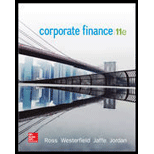
Replacement Decisions Suppose we are thinking about replacing an old computer with a new one. The old one cost us $450,000; the new one will cost $580,000. The new machine will be
- a. Suppose we recognize that if we don’t replace the computer now, we will be replacing it in two years. Should we replace now or should we wait? (Hint: What we effectively have here is a decision either to “invest” in the old computer-by not selling it-or to invest in the new one. Notice that the two investments have unequal lives.)
- b. Suppose we consider only whether we should replace the old computer now without worrying about what’s going to happen in two years. What are the relevant cash flows? Should we replace it or not? (Hint: Consider the net change in the firm’s aftertax cash flows if we do the replacement.)
a)
To determine: Net present value of the old and new computer.
Equivalent Annual Cost:
Equivalent annual cost is that cost which shows the operating and maintaining cost of the assets of whole life.
Net Present Value(NPV):
The net present value is differential amount between the net cash inflow from future investments and net cash outflow in the form of cost that the company has to pay at present as initial cost of the investment.
Explanation of Solution
Given,
Salvage value of the old computer is $230,000.
Salvage value of the computer after two years is $60,000.
Cost of new computer is $580,000.
Estimated life of the computer is 5 years.
Salvage value of the new computer is $130,000.
Operating cost is $85,000.
Discount rate is 14%.
Calculated values,
Book value of the old computer is $270,000.
Annual depreciation on the old computer is $90,000.
Formula to calculate the equivalent annual cost of the old computer,
Substitute-$133,966 for the net present value and 1.647 for the PVIFA.
Formula to calculate the equivalent annual cost of the new computer,
Substitute, -$205,923 for the net present value and 3.433 for the PVFA,
Working notes:
Calculate the operating cash flow of old computer,
Calculate the operating cash flow of new computer,
Calculate the present salvage value of new computer,
Calculate the present salvage value of the old computer,
Calculate the initial cost of the old computer,
Calculate the net present value of the old computer,
Calculate the net present value of the new computer,
Hence, equivalent annual cost of old and new computer is -$81,339 and -$59,983.
b)
To determine: Incremental net present value.
Net Present Value(NPV):
The net present value is differential amount between the net cash inflow from future investments and net cash outflow in the form of cost that the company has to pay at present as initial cost of the investment.
Explanation of Solution
Formula to calculate the incremental net present value,
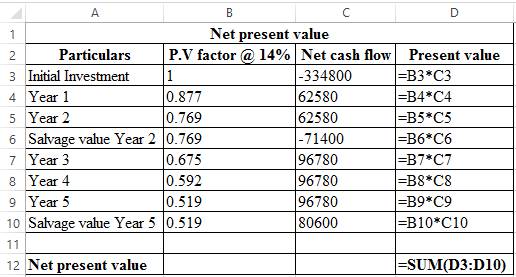
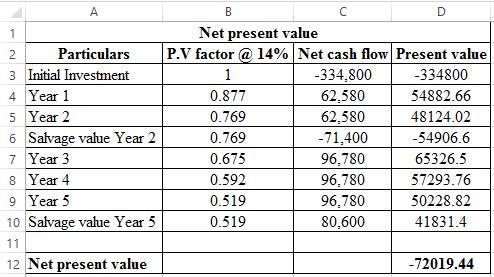
Working notes:
Calculate the incremental cash flows,
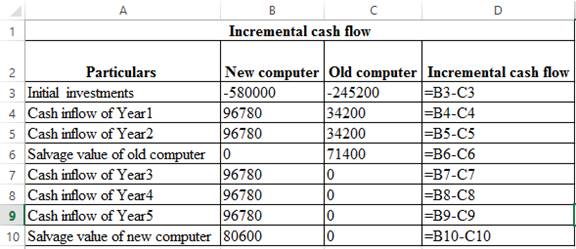
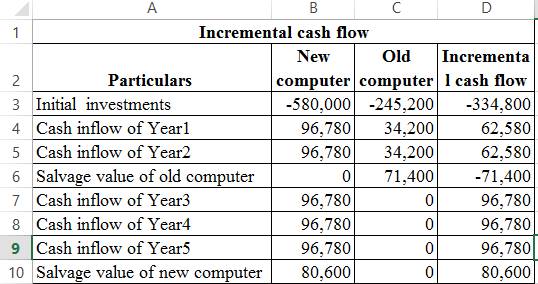
Hence, net present value is -$72,019.
Want to see more full solutions like this?
Chapter 6 Solutions
Corporate Finance (The Mcgraw-hill/Irwin Series in Finance, Insurance, and Real Estate)
- Don't used hand raitingarrow_forwardDon't used Ai solutionarrow_forwardAssume an investor deposits $116,000 in a professionally managed account. One year later, the account has grown in value to $136,000 and the investor withdraws $43,000. At the end of the second year, the account value is $107,000. No other additions or withdrawals were made. During the same two years, the risk-free rate remained constant at 3.94 percent and a relevant benchmark earned 9.58 percent the first year and 6.00 percent the second. Calculate geometric average of holding period returns over two years. (You need to calculate IRR of cash flows over two years.) Round the answer to two decimals in percentage form.arrow_forward
- Please help with the problem 5-49.arrow_forwardPlease help with these questionsarrow_forwardIn 1895, the first U.S. Putting Green Championship was held. The winner's prize money was $170. In 2022, the winner's check was $3,950,000. a. What was the percentage increase per year in the winner's check over this period? Note: Do not round intermediate calculations and enter your answer as a percent rounded to 2 decimal places, e.g., 32.16. b. If the winner's prize increases at the same rate, what will it be in 2053? Note: Do not round intermediate calculations and enter your answer as a percent rounded to 2 decimal places, e.g., 32.16. a. Increase per year b. Winners prize in 2053 %arrow_forward
- Derek plans to retire on his 65th birthday. However, he plans to work part-time until he turns 73.00. During these years of part-time work, he will neither make deposits to nor take withdrawals from his retirement account. Exactly one year after the day he turns 73.0 when he fully retires, he will begin to make annual withdrawals of $183,008.00 from his retirement account until he turns 94.00. After this final withdrawal, he wants $1.52 million remaining in his account. He he will make contributions to his retirement account from his 26th birthday to his 65th birthday. To reach his goal, what must the contributions be? Assume a 6.00% interest rate. Round to 2 decimal places.arrow_forwardDerek plans to retire on his 65th birthday. However, he plans to work part-time until he turns 71.00. During these years of part-time work, he will neither make deposits to nor take withdrawals from his retirement account. Exactly one year after the day he turns 71.0 when he fully retires, he will begin to make annual withdrawals of $177,333.00 from his retirement account until he turns 94.00. He he will make contributions to his retirement account from his 26th birthday to his 65th birthday. To reach his goal, what must the contributions be? Assume a 9.00% interest rate. Submit Answer format: Currency: Round to: 2 decimal places.arrow_forwardDerek plans to retire on his 65th birthday. However, he plans to work part-time until he turns 72.00. During these years of part-time work, he will neither make deposits to nor take withdrawals from his retirement account. Exactly one year after the day he turns 72.0 when he fully retires, he will wants to have $3,104,476.00 in his retirement account. He he will make contributions to his retirement account from his 26th birthday to his 65th birthday. To reach his goal, what must the contributions be? Assume a 8.00% interest rate. Submit Answer format: Currency: Round to: 2 decimal places.arrow_forward
